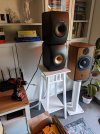About the BBC dip...
SETUP
To investigate the BBC dip, I first searched for a definition. I found reliable sources which define it as a mild dip of about -3dB beginning at 1000Hz and ending between 3000 and 4000Hz. Using that information, I dialed in such a dip in Dirac Live 3, which I use daily in my home office, where my KEF R3s delight me daily. I normally correct to to 1000Hz, so I had to draw a custom full range curve, then modify that with an approximation of the BBC dip as previously defined. This is how that looks:
View attachment 251609
The Dirac Live Processor allows you to save up to 8 presets and switch between them instantly:
View attachment 251619
Then I measured the results, which came out pretty close. The dip extends a bit beyond 4000Hz, but the delta is < 1dB, so I decided to go with it.
View attachment 251614
View attachment 251615
LISTENING TESTS
[Signal chain: PC -> USB -> Schiit Modius -> Peachtree Nova 300 -> KEF R3]
In listening to unfiltered pink noise while taking those MMM measurements, I could very easily hear the dip and therefore though listening tests would be a cakewalk. I was wrong.
My initial test involved listening to an Amazon Music HD playlist I made years ago featuring music from the
Guardians of the Galaxy movies. A lot of classic rock has what I would call edgy glare in portions of the program when heard on a capable system. You know, where it sounded fine to you in the car for 20 years, and then you discovered it was not as well-produced as you thought. Several songs in that playlist have that sort of glare, and I imagined it might fall in the frequency band of the BBC dip and be helped by the broad reduction there.
As I listened to the playlist, I swapped presets every time I heard that edginess only to find it was not improved. In fact, under almost all circumstances, I heard no difference at all between flat full correction and BBC full correction. Hmmm...
The only differences I could be sure I heard were limited to drums and percussion and some piano passages. Why? Because only the 2nd and 3rd octave overtones of rock instruments and voices fall into the range covered by the dip, and they are -10dB or more down in SPL. Soprano voices and 6 string guitars end around 1000Hz, for example. There simply is not much program material in that region in rock and roll. A spectrum analyzer clearly shows this to be true. (Jethro Tull excepted, of course.)
Knowing this, I switched to Santana's
Abraxas album. The difference there is much more palpable due to the amount of latin percussion in the music. I had a definite preference for the flat curve, as the BBC dip sounded artificially dull with instruments having inaccurate tonality.
I then listened to T
he London Symphony Orchestra Performs the Music of Sting. Here, the difference was often obvious, depending upon the mix of instruments playing. Again, I very much preferred the flat curve.
However, I can see a case being made for a -1 or -1.5dB in that region to reduce some of the forwardness of woods, strings, brass instruments in the latter album. I can also see how the BBC dip may be preferred by someone with hearing sensitivities within its range.
The BBC could use this dip to reduce a speaker cone resonance for all those years, because there is not much signal occupying that space in a typical TV broadcast comprised of voices and background music. Certainly not such that anyone would notice nor care.
Finally, to throw
@preload a bone, I dialed in +1.5dB peak at 10KHz. This added stick presence to cymbals. It sounded artificial to me, like the midrange and treble part of a smile EQ was in play, or someone mashed the loudness button on the boombox.
The last point I will make is I prefer Dirac with correction limited to 1KHz over both of these new curves. This is why - the normal response of these speakers in this room and what I listen to daily:
View attachment 251620
View attachment 251621
For reference:
View attachment 251623

